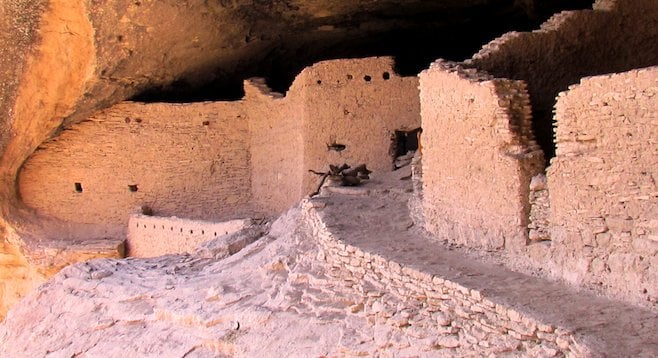 Facebook
Facebook
 X
X
 Instagram
Instagram
 TikTok
TikTok
 Youtube
Youtube

Along the Gila River built into five interconnected caves high in a canyon wall, in the 2.7-million-acre Gila National Forest and Wilderness Area, is a 700-year-old Mogollon pueblo designated as the Gila Cliff Dwellings National Monument.
Although only 47 miles from Silver City, New Mexico, it takes hours to arrive at the dwellings due to the steep-pitched shoulderless road that snakes through the forest where speed limits rarely exceed 40 m.p.h. and herds of cattle free range. The rugged terrain and plunging canyons of this southwestern corner of New Mexico have left the region undeveloped. Be forewarned: for this reason, glorious, unadulterated 360-degree views appear through the trees at nearly every bend.

Not surprisingly, two National Scenic Byways lined with belts of wild sunflowers, yellowing aspens and Ponderosa pines transverse the forest, the Geronimo Trail National Scenic Byway and the Trail of the Mountain Spirits Scenic Byway.
A tributary of the Colorado River, the headwaters of the 650-mile Gila is said to have been the birthplace of Geronimo. The river, incidentally, was also the impetus for 25 German WWII POWs to dig a 178-foot tunnel and escape from the Papago Park Prisoner of War Camp in 1944. Due to the efficiency of the newly constructed Hoover Dam, the riverbed was a dust-filled arroyo and they didn’t get far.
Archeologists have determined that there had been 46 masonry rooms housing up to 15 families in the cliff. Most of the wooden lintels are original, although about 90% of the artifacts that had once been in the dwellings were looted, including several mummified human remains.
The cliff dwellings are not the only ancient ruins within the forest. Overlooking Lake Roberts, one of three manmade reservoirs within the forest, are ruins of a pit house settlement. Ruins have also been located above the cliff and at the base of several sandstone buttes.
The second-most visited site in the Gila National Forest is the Catwalk National Recreation Trail. It's a hanging walkway that retraces a former “catwalk” that ran above a water pipeline feeding a mine. (The catwalk is currently closed due to the Whitewater/Baldy Fire Complex.)
There are numerous campgrounds within the forest and monument, several near natural hot springs, and a few lodges, hotels and B&Bs towards the outer edge of the forest. The extremely affordable Little Toad Creek Inn and Tavern with its attentive and inviting staff, however, is centrally located at the junction of Routes 15 and 35 south of the monument.
Although food as well as spirits may be procured at the downstairs tavern (which will soon be distilling its own whiskey and brewing its own ale), the posh dining room that claims the upper level of the lodge serves an incredible gourmet seasonal menu offering selections like the pecan-encrusted pesto pinwheel pork loin, a slab of succulent lamb drenched in a marsala balsamic reduction, and crispy orange ginger tilapia. The creamy butternut soup was delicate, yet full of flavor, and the Golden Ball of Light, a bulbous blob of vanilla ice cream rolled in roasted coconut flakes and candied lavender, was uniquely delightful.
Although the Tavern hosts live music regularly, it also hosts the forest’s annual Hummingbird Festival, drawing birders from around the globe.
With the eighth-annual Gila River Festival scheduled for September 13-16, staff will gladly connect patrons with local outfitters and tour guides able to tailor your visit according to your particular interests. The New Mexico Wilderness Alliance offers the Gila Wilderness Wolf Backpack package, and the ornithologists and conservation biologists at Gila Backcountry Services lead hikers and equestrians on Nature Study Tours. Wild by Nature conducts women-led tours, and WolfHorse Outfitters hosts Native American–led extreme adventures.


Along the Gila River built into five interconnected caves high in a canyon wall, in the 2.7-million-acre Gila National Forest and Wilderness Area, is a 700-year-old Mogollon pueblo designated as the Gila Cliff Dwellings National Monument.
Although only 47 miles from Silver City, New Mexico, it takes hours to arrive at the dwellings due to the steep-pitched shoulderless road that snakes through the forest where speed limits rarely exceed 40 m.p.h. and herds of cattle free range. The rugged terrain and plunging canyons of this southwestern corner of New Mexico have left the region undeveloped. Be forewarned: for this reason, glorious, unadulterated 360-degree views appear through the trees at nearly every bend.

Not surprisingly, two National Scenic Byways lined with belts of wild sunflowers, yellowing aspens and Ponderosa pines transverse the forest, the Geronimo Trail National Scenic Byway and the Trail of the Mountain Spirits Scenic Byway.
A tributary of the Colorado River, the headwaters of the 650-mile Gila is said to have been the birthplace of Geronimo. The river, incidentally, was also the impetus for 25 German WWII POWs to dig a 178-foot tunnel and escape from the Papago Park Prisoner of War Camp in 1944. Due to the efficiency of the newly constructed Hoover Dam, the riverbed was a dust-filled arroyo and they didn’t get far.
Archeologists have determined that there had been 46 masonry rooms housing up to 15 families in the cliff. Most of the wooden lintels are original, although about 90% of the artifacts that had once been in the dwellings were looted, including several mummified human remains.
The cliff dwellings are not the only ancient ruins within the forest. Overlooking Lake Roberts, one of three manmade reservoirs within the forest, are ruins of a pit house settlement. Ruins have also been located above the cliff and at the base of several sandstone buttes.
The second-most visited site in the Gila National Forest is the Catwalk National Recreation Trail. It's a hanging walkway that retraces a former “catwalk” that ran above a water pipeline feeding a mine. (The catwalk is currently closed due to the Whitewater/Baldy Fire Complex.)
There are numerous campgrounds within the forest and monument, several near natural hot springs, and a few lodges, hotels and B&Bs towards the outer edge of the forest. The extremely affordable Little Toad Creek Inn and Tavern with its attentive and inviting staff, however, is centrally located at the junction of Routes 15 and 35 south of the monument.
Although food as well as spirits may be procured at the downstairs tavern (which will soon be distilling its own whiskey and brewing its own ale), the posh dining room that claims the upper level of the lodge serves an incredible gourmet seasonal menu offering selections like the pecan-encrusted pesto pinwheel pork loin, a slab of succulent lamb drenched in a marsala balsamic reduction, and crispy orange ginger tilapia. The creamy butternut soup was delicate, yet full of flavor, and the Golden Ball of Light, a bulbous blob of vanilla ice cream rolled in roasted coconut flakes and candied lavender, was uniquely delightful.
Although the Tavern hosts live music regularly, it also hosts the forest’s annual Hummingbird Festival, drawing birders from around the globe.
With the eighth-annual Gila River Festival scheduled for September 13-16, staff will gladly connect patrons with local outfitters and tour guides able to tailor your visit according to your particular interests. The New Mexico Wilderness Alliance offers the Gila Wilderness Wolf Backpack package, and the ornithologists and conservation biologists at Gila Backcountry Services lead hikers and equestrians on Nature Study Tours. Wild by Nature conducts women-led tours, and WolfHorse Outfitters hosts Native American–led extreme adventures.
Comments